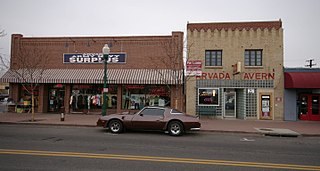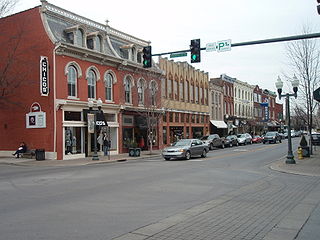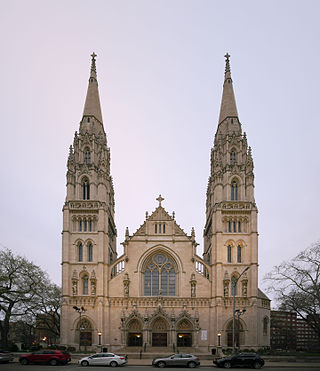
The Downtown Miami Historic District is a U.S. historic district located in the Central Business District of Downtown Miami, Florida.

Downtown Paterson is the main commercial district of Paterson, Passaic County, in the U.S. state of New Jersey. The area is the oldest part of the city, along the banks of the Passaic River and its Great Falls. It is roughly bounded by Interstate 80, Garret Mountain Reservation, Route 19, Oliver Street, and Spruce Street on the south; the Passaic River, West Broadway, Cliff Street, North 3rd Street, Haledon Avenue, and the borough of Prospect Park on the west; and the Passaic River also to the north.

Downtown Oakland is the central business district of Oakland, California, United States. It is located roughly bounded by both the Oakland Estuary and Interstate 880 on the southwest, Interstate 980 on the northwest, Grand Avenue on the northeast, and Lake Merritt on the east.

Downtown Grand Forks is the original commercial center of Grand Forks, North Dakota, United States. Located on the western bank of the Red River of the North, the downtown neighborhood is situated near the fork of the Red River and the Red Lake River. While downtown is no longer the dominant commercial area of the Greater Grand Forks community, it remains the historic center of Grand Forks. An 80.4-acre (32.5 ha) portion was listed on the National Register of Historic Places in 2005, as Downtown Grand Forks Historic District. Today, downtown Grand Forks is home to many offices, stores, restaurants, and bars.

Beaufort Historic District is a historic district in Beaufort, South Carolina. It was listed on the National Register of Historic Places in 1969, and was declared a National Historic Landmark in 1973.

Olde Town Arvada is a 15.1-acre (6.1 ha) historic district in Arvada, Colorado bounded by Ralston Road, Teller Road, Grandview Avenue and Yukon Street. It was listed on the National Register of Historic Places in 1998. The listing included 42 contributing buildings.

There are nine historic districts in Meridian, Mississippi. Each of these districts is listed on the National Register of Historic Places. One district, Meridian Downtown Historic District, is a combination of two older districts, Meridian Urban Center Historic District and Union Station Historic District. Many architectural styles are present in the districts, most from the late 19th century and early 20th century, including Queen Anne, Colonial Revival, Italianate, Art Deco, Late Victorian, and Bungalow.

The Dwight Street Historic District is an irregularly shaped 135-acre (55 ha) historic district in New Haven, Connecticut. The district is located immediately west of the center of Downtown New Haven and is generally bounded by Elm Street on the north, Park Street on the east, North Frontage Road on the south, and Sherman Avenue on the west. It contains one of the city's highest concentrations of well-preserved 19th and early 20th-century residential architecture, much of which was developed for the working classes in the city's factories. It was listed on the National Register of Historic Places in 1983. The historic district includes most of the Dwight neighborhood and several blocks of the northeast corner of the West River neighborhood.

There are 75 properties listed on the National Register of Historic Places in Albany, New York, United States. Six are additionally designated as National Historic Landmarks (NHLs), the most of any city in the state after New York City. Another 14 are historic districts, for which 20 of the listings are also contributing properties. Two properties, both buildings, that had been listed in the past but have since been demolished have been delisted; one building that is also no longer extant remains listed.

The Downtown Norwich Historic District is a historic district representing the core of the downtown area of the city of Norwich, Connecticut in the United States. It was listed on the National Register of Historic Places in 1985. It includes 115 contributing buildings and one other contributing structure over a 64-acre (26 ha) area. Several buildings in the historic district are also individually listed on the National Register, including the Norwich Town Hall, the Telephone Exchange Building and the Carroll Building.

The Downtown Commercial Historic District in Muscatine, Iowa is a historic district that was listed on the National Register of Historic Places in 2006. At that time, it included 93 contributing buildings, one other contributing object, and 18 non-contributing buildings. The city of Muscatine was established as Bloomington in 1836. The original town was built on land that is generally flat along the Mississippi River. Residential areas were located on the surrounding hills. Commercial and industrial interests developed on the flatter land near the river. Muscatine's commercial and industrial center had developed in a 12-block area along Front Street, now Mississippi Drive, and 2nd Street between Pine Street and Mulberry Street by 1874. This area, represented by the Downtown Commercial Historic District, is the city's original commercial area. Within its boundaries is a large number of 19th-century commercial buildings, many of which were modified in the first half of the 20th century.

The Bridgeport Downtown South Historic District encompasses the historic elements of the southern part of downtown Bridgeport, Connecticut. It is 27 acres (11 ha) in size, roughly bordered on the east by Main and Middle Streets, on the north by Elm Street, the west by Broad Street, and the south by Cesar Batalla Way. This area includes the highest concentration of buildings developed in the commercial downtown between about 1840 and the 1930s, the period of the city's major growth as a manufacturing center, and includes a diversity of architectural styles representative of that time period. The district was listed on the National Register of Historic Places in 1987.

Franklin Historic District is a historic district in Franklin, Tennessee that was listed on the National Register of Historic Places in 1972. It was created to preserve historic commercial and residential architecture in a 16-block area of the original, downtown Franklin around the north, west, and south of the town square.

Saint Paul Cathedral is the mother church of the Diocese of Pittsburgh in Pittsburgh, Pennsylvania. St. Paul's parish was established in 1833.

The Downtown Commercial Historic District encompasses most of the central business district of Burlington, Iowa, United States. It was listed on the National Register of Historic Places in 2015. The historic district includes 65 properties that were part of a 2012 to 2013 survey of the area. It also includes as contributing properties the buildings in the West Jefferson Street Historic District and three buildings in the Manufacturing and Wholesale Historic District that were previously listed on the National Register. All total there are 122 resources within the district, which includes 108 contributing and 14 non-contributing properties.

The Mason City Downtown Historic District is a nationally recognized historic district located in Mason City, Iowa, United States. It was listed on the National Register of Historic Places in 2005. At the time of its nomination it contained 93 resources, which included 63 contributing buildings, one contributing site, four objects, 22 non-contributing buildings, and three non-contributing objects. Platted in 1855, Mason City is a commercial and industrial center for north central Iowa. It was also a railroad center, but the tracks bypassed the central business district in order to serve the industries located on the north side of town and the wholesale enterprises on the south side. Central Park, a public square, was part of the city's original plat and is the contributing site.

Upper Main Street Historic District is a nationally recognized historic district located in Dubuque, Iowa, United States. It was listed on the National Register of Historic Places in 2005. At the time of its nomination it consisted of 24 resources, which included 18 contributing buildings, and six non-contributing buildings. In 2011 the boundaries of the district were expanded to include four additional buildings on the west side of the 900 block of Main Street. The district is the northern end of the city's most important commercial street. It is situated on a level terrace above the downtown area, located to the east. The buildings located on the east side of Main Street have exposed foundations along the alley because the grade descends in that direction. For the most part the district is made up of commercial buildings, although there is one house, four rowhouses, and a church. All of the buildings are masonry construction, and they are between one and four stories tall. The bell tower of St. Luke's United Methodist Church (1896) is equivalent to an eight-story building. St. Luke's Church and the Interstate Power Company Building are individually listed on the National Register.

The Red Oak Downtown Historic District is a nationally recognized historic district located in Red Oak, Iowa, United States. It was listed on the National Register of Historic Places in 2016. At the time of its nomination it contained 104 resources, which included 73 contributing buildings, eight contributing objects, one contributing site, 15 non-contributing buildings, six non-contributing objects, and one non-contributing structure. The historic district covers most of the city's central business district. It is a flat area of land in an otherwise hilly region. The district is centered on Fountain Square, a public green space around which the town had been platted in 1857. A second public square was added in 1890 for the Montgomery County Courthouse after Red Oak won a special election to move the county seat from Frankfort.

The Iowa City Downtown Historic District is a nationally recognized historic district located in Iowa City, Iowa, United States. It was listed on the National Register of Historic Places in 2021. At the time of its nomination it consisted of 102 resources, which included 73 contributing buildings, one contributing site, one contributing object, 21 non-contributing buildings, and seven non-contributing objects. Eight buildings that were previously listed on the National Register are also included in the district. Iowa City's central business district developed adjacent to the Iowa Old Capitol Building and the main campus of the University of Iowa. This juxtaposition gives the area its energy with the overlap of university staff and students and the local community. The district was significantly altered in the 1970s by the city's urban renewal effort that brought about the Ped Mall, which transformed two blocks of College Street from Clinton Street to Linn Street and Dubuque Street from Burlington Street to Washington Street. It is the contributing site and the large planters/retaining walls that are original to the project are counted together as the contributing object. There are also several freestanding, limestone planters, five contemporary sculptures, and a playground area are the non-contributing objects.
























